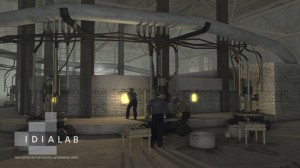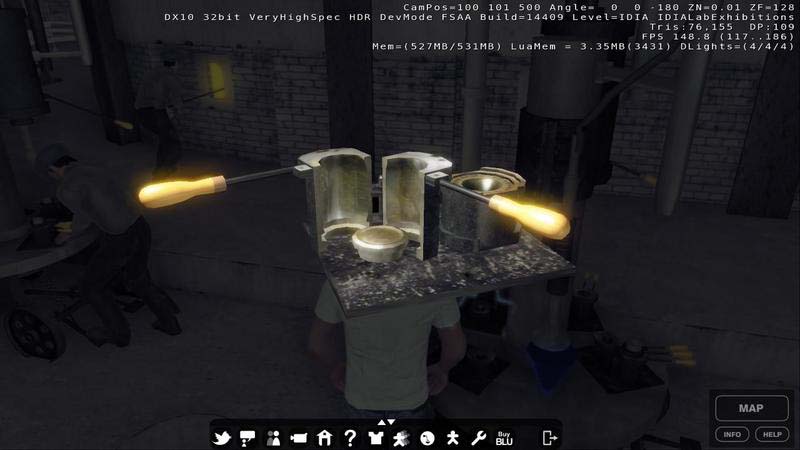 The IDIA has assembled an interdisciplinary group of students, faculty and industry experts in a significant interactive information portal for the Ball State University Museum of Art (BSUMA). The IDIA team is developing an innovative touch-based interface to navigate the collection, employing and integrating Microsoft Surface with the Museum’s database. The Surface will afford Museum patrons a collaborative, participatory public platform through which to access metadata and media of the physical exhibition – as well as extending virtually into the permanent collection. Using the Digital Images Delivered Online (DIDO) database, the interface will make visual the interconnection between works in the collection queried on searchable parameters, i.e. artist, medium, period, subject etc. This two-semester immersive project supported by the BSU Provost’s Immersion Initiative has been team-taught and has recruited students from targeted disciplines across campus.
The IDIA has assembled an interdisciplinary group of students, faculty and industry experts in a significant interactive information portal for the Ball State University Museum of Art (BSUMA). The IDIA team is developing an innovative touch-based interface to navigate the collection, employing and integrating Microsoft Surface with the Museum’s database. The Surface will afford Museum patrons a collaborative, participatory public platform through which to access metadata and media of the physical exhibition – as well as extending virtually into the permanent collection. Using the Digital Images Delivered Online (DIDO) database, the interface will make visual the interconnection between works in the collection queried on searchable parameters, i.e. artist, medium, period, subject etc. This two-semester immersive project supported by the BSU Provost’s Immersion Initiative has been team-taught and has recruited students from targeted disciplines across campus.
Complete Instruction Guide here: http://ilocker.bsu.edu/users/idiaa/world_shared/SurfaceInstructions.pdf
Microsoft Surface represents a fundamental change in the potential for interaction with digital content. The Surface is a 30” tabletop interface environment that allows several people to work independently or collaboratively – all without using a mouse or a keyboard. The Surface allows users to navigate information physically, and manipulate information with natural gestures and touch http://www.microsoft.com/SURFACE/product.html#section=The%20Product.
The Ball State University Museum of Art has a collection of nearly 11,000 works of art. Central to the Ball State University Museum of Art’s mission is the provision of educational programming that will further faculty, staff, student, and public utilization and understanding of the Museum and its collection, of museums in general, and of the arts. To accomplish this goal, the Museum offer tours, talks, materials for teachers, an education database, artist demonstrations. The Museum’s education philosophy centers on bringing together the needs of visitors and the resources of the Museum , and balancing responsibility to the university with service to the community. In facilitating communication between the work of art and the viewer, the Museum subscribes to a philosophy of learner-centered programming informed by a thorough knowledge of the collection and methods and strategies for effective teaching.
Although the Museum’s collection numbers nearly 11,000, given the physical constraints of the facility, a mere 10% of the collected works are currently displayed at any given time. The incorporation of this hybrid Surface and database system will afford patrons virtual access to the entire collection – making visible those works currently stored. More importantly, the system will allow patrons to visualize the interconnectivity of the works according to multiple facets – visually re-contextualizing the works in relation to specified search parameters. This form of innovative technology within a museum context would typically be installed at major metropolitan institutions. Development of this interface at the Ball State University Museum of Art will not only benefit local community groups and patrons of BSUMA whose access to the collection will be significantly augmented, but also has the potential to influence other museums through the distribution of the outcomes of this product.
The Institute for Digital Intermedia Arts (IDIA) has a history of providing interdisciplinary immersion and new media experiences, employing pedagogy that supports students’ transformation as active, engaged learners. The Institute provides a dynamic exchange between instructor and students – where participants engage in collaborative, inquiry-based communities that provide an environment, which fosters participatory learning. As opposed to a traditional model, where knowledge is imparted by the teacher to the student, participatory learning can transform the learner into an active role. Participatory learning communities engage in a dynamic conversation centered around a subject – where analysis, comparison, and evaluation are core to the process of acquiring meaning and relationships. This environment allows students the opportunity to have a stake in the conditions of their learning, making decisions that direct their course of investigation. With a commitment to active inquiry, participants are freed to create personal and collective meaning.
BSU MUSEUM OF ART
COLLECTION PORTAL
SOFTWARE DESIGN
Carrie Arnold
Joel Happ
Garret Orth
Deekshita Reddy
Christopher Ross
Jonathan Strong
Austin Toombs
INTERFACE DESIGN
Anastasia Goryacheva
Steven Lanier
Jonathan Strong
ELECTRONICS
Eric Brockmeyer
Giovanni Rozzi
GRAPHIC DESIGN
Amy Goettemoeller
Ina-Marie Henning
FACULTY
Jesse Allison
John Fillwalk
Paul Gestwicki
PROJECT DIRECTOR
Jonathan Strong
A SPECIAL THANK YOU
UNIVERSITY LIBRARIES
James Bradley
John Straw
Budi Wibowo
SOUND
Rick Baker
Steven Lanier
Giovanni Rozzi
STRUCTURAL DESIGN
Eric Brockmeyer
Matthew Wolak
PROJECT MANAGEMENT
Ina-Marie Henning
Amruta Mhaiskar
Jennifer Weaver-Cotton
PRODUCER/PRINCIPLE INVESTIGATOR
John Fillwalk
BALL STATE UNIVERSITY MUSEUM OF ART
Peter Blume
Carl Schafer
Tania Said
Ball State University Museum of Art
College of Fine Arts
College of Architecture and Planning
Department of Architecture
Department of Art
Department of Computer Science
School of Music
Information Technology
O�ffice of the Provost
University Libraries
and
Jeff� Berg, IBM Interactive, IDIA Research Fellow
IDIA Presents: BSU MUSEUM OF ART COLLECTION PORTAL 3/20/11 at 2:30pm BSUMA
BSU MUSEUM OF ART COLLECTION PORTAL
Reception and Gallery Talk
Thursday, March 20 @ 2:30pm, BSU Museum of Art
The BSU Museum of Art Collection Portal was developed by students, faculty and industry research fellows in the Institute for Digital Intermedia Arts at Ball State University. The year-long project was developed in partnership with the Ball State University Museum of Art and sponsored by the Provost’s Immersive Learning Initiative.
This interdisciplinary team from art, computer science, architecture and music has developed an innovative, touch-based application to navigate the collection. The portal bridges the Microsoft Surface interface with the Museum’s collection database, the Digital Images Delivered Online (DIDO), hosted on the Digital Media Repository of Bracken Library. The Surface affords Museum visitors an interactive platform to individually or collaboratively make virtual connections between works of art both on display and in reserve – accessing information and media across the collection.
http://bit.ly/IDIA_Surface
Complete Instruction Guide here: http://ilocker.bsu.edu/users/idiaa/world_shared/SurfaceInstructions.pdf
 interActivity was a collaborative art system at the Ball State University Art Museum on February 25th 2007. It was hosted in conjunction with the Engaging Technology exhibit run by the newly minted IDIAA.
interActivity was a collaborative art system at the Ball State University Art Museum on February 25th 2007. It was hosted in conjunction with the Engaging Technology exhibit run by the newly minted IDIAA.



























